September
This month’s focus is on building relationships and collecting data. The content aligns with Quality Indicator II: Effective Teams on the Rubric of Effective Practices for Students with Complex Access Needs and the Administrator Companion Document to the Rubric of Effective Practices for Students with Complex Access Needs. Last month, you set up classroom systems to provide structure and ease anxiety for your students and staff. This month, you will actively work on creating positive relationships with your students, their families, and your colleagues. You will hone your progress monitoring skills which will contribute to an effective team that uses data-driven decisions to facilitate student progress. Download or print the September Monthly Instructional Guide Checklist for your reference.
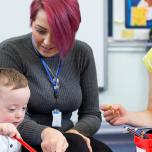
Significant Cognitive Disabilities, Instruction, ARD/IEP Supports, Assistive Technology
Rubric of Effective Practices for Students with Significant Cognitive Disabilities
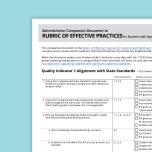
Significant Cognitive Disabilities, ARD/IEP Supports, Instruction, Assistive Technology, Behavior, Inclusion
Administrator Companion Document to the Rubric of Effective Practices for Students with Complex Access Needs
Building Relationships
As the teacher in a self-contained classroom, you will build relationships with:
- students,
- students’ families,
- paraprofessionals,
- general education teachers, and
- other instructional and related service providers.
Students
At the end of August’s Monthly Instructional Guide, we talked about starting out the year using activities with minimal cognitive demands to get students used to the schedule and procedures. We mentioned pairing yourself with positive experiences and items to build rapport with your students. This pairing makes students feel safe and supported, while showing them that working and following directions leads to positive consequences. With pairing, you are the “giver” of the good things, through positive attention and tangibles, and are not just associated with high demands and difficult transitions. As your relationships with your students grow, you can increase the complexity of their tasks.
This month, continue learning about your students’ preferences and finding ways to integrate them into daily activities in the classroom. Find what your students like through observations, interviews, and/or by using preference surveys and running reinforcer trials with students.
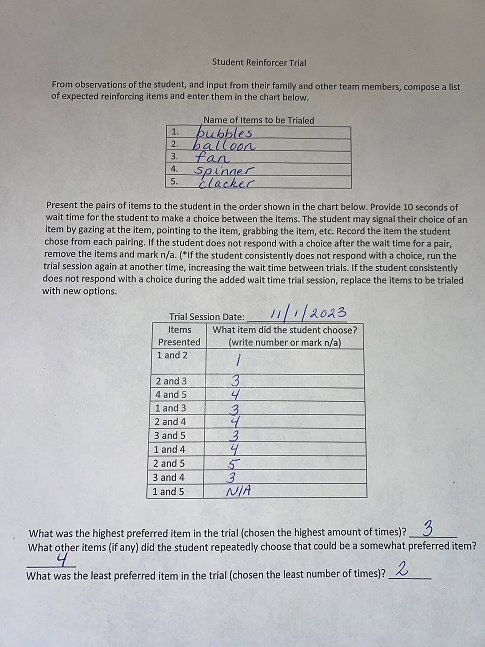
Student reinforcer trial data. Shannon Beyer-Kaminski, 2023
Gathering information on student interests, preferences, and reinforcers is a great way to have students begin advocating for themselves and participating in the development of their IEPs while also helping to develop a relationship of trust and respect.
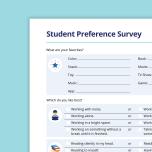
Significant Cognitive Disabilities
Student Preference Survey
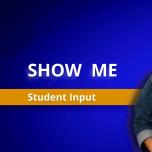
ARD/IEP Supports, Significant Cognitive Disabilities, Evaluation
Student Input

I'm Determined
Students’ Families
Families can be a great resource for identifying student preferences and they provide valuable input for IEP development. Establishing a relationship with families allows you to easily tap into their vast knowledge of the student and create a strong foundation for the student across school, home, and community settings.
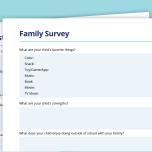
Significant Cognitive Disabilities
Family Input Survey

ARD/IEP Supports, Significant Cognitive Disabilities, Evaluation
Family Input
This month, think about your procedures for family communication. It is important to maintain regular communication with families, and not just contact them right before admission, review, and dismissal (ARD) committee meetings. Considerations when refining procedures for family communication:
- Have you established guidelines for family communication in your classroom manual? Paraprofessionals’ contact with families should be brief and general, while student-specific questions and concerns should go through you as the teacher.
- How are you contacting families, and how can they contact you? You can send home daily journals or weekly newsletters, have a classroom webpage, or use your school’s digital communication platform to share information. Take into consideration families’ preferred time of day, frequency of contact, and methods of communication (e.g., emails, phone calls, and conferences). Be clear about when you will be able to check messages from families and offer a timeframe for them to expect a response, aligning to your school/district expectations for response time.
- How are you keeping data on family communication? Whether you are saving conference notes or jotting down times and topics of phone calls, having a log of family communication can be helpful.
- Have you sent out surveys or completed interviews to gather student information? Families have so much to contribute. Reach out to them for valuable input and let them know you appreciate the collaboration and support from home.
- Are you contacting families for more positive reasons than negative ones? Share topics that the class is learning about and let families know about student successes. When you need to bring up a concern, think about how to add some positivity. Instead of reporting, “Bert was being stubborn and would not get off the computer when it was time. I asked him repeatedly and then he threw a fit,” rephrase it to “Bert had difficulty transitioning from the computer today, but he was able to turn it around in 5 minutes. This is an improvement of 10 minutes from yesterday! We will keep working on it. Do you have any suggestions on what might help?” Having concrete data takes away emotion and focuses on facts.
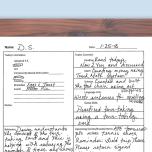
Autism, Behavior
Family/Teacher Communication Form
Paraprofessionals
Your paraprofessionals are vital to your classroom. Clearly defining roles and responsibilities, keeping open lines of communication, and showing genuine appreciation for their support will help develop positive relationships with your paraprofessionals. Continue adding revising your classroom manual as you continue to meet with your team to see what is and is not working.

Significant Cognitive Disabilities, Instruction
Defining Team Roles and Responsibilities

Significant Cognitive Disabilities, Instruction
Setting an Agenda for Team Meetings
General Education Teachers
Building relationships with your students’ general education teachers helps make scheduling and supporting students easier. Transitioning between classrooms can be difficult for students and you will need to work together to ensure the student has access to all learning environments. Additionally, general education teachers are masters of the curriculum, so you can tap into their knowledge and resources to design rigorous lessons for your students that address the TEKS. We will talk more about teaching with rigor in the October Monthly Instructional Guide.
Share your own knowledge of accommodations and modifications to help the student access learning as independently as possible in the general education classroom. If possible, meet regularly to brainstorm and problem-solve. You will strengthen your relationships with general education teachers through this open collaboration.
Instructional and Related Service Providers
Students in your self-contained classroom may have a variety of instructional and related service providers that offer specialized support. These may include speech language pathologists, occupational therapists, physical therapists, and other valuable personnel. Open communication and regular collaboration with these members, not just at the ARD committee meeting, helps a student’s team stay on top of progress and troubleshoot challenges. Having solid relationships with these providers can lead to the student’s generalization of skills across different people and settings.
Collecting Data
Establish methods to collect and analyze data to make data-driven decisions for:
- academics,
- behavior,
- communication,
- and other areas as indicated by IEP goals.
Academics
You will be tracking academic performance on classroom work for report card grades and for any student’s academic IEP goals to be reported in their IEP progress report. Students served in an early childhood special education (ECSE) classroom may only be receiving their IEP progress report, depending on their enrolled grade level.
Academic goal tracking sheet. Shannon Beyer-Kaminski, 2023
Behavior
The more organized your classroom is, the more structured your routines and procedures are, and the stronger your relationships are with students, the less chance you will have unexpected behaviors occurring. However, sometimes behaviors still occur, and you will need to collect data to determine the function of the behaviors and brainstorm interventions with the student’s team. Students with significant behavior supports, behavior IEP goals, or a behavior intervention plan (BIP) would have specific behaviors and interventions that need to be monitored.
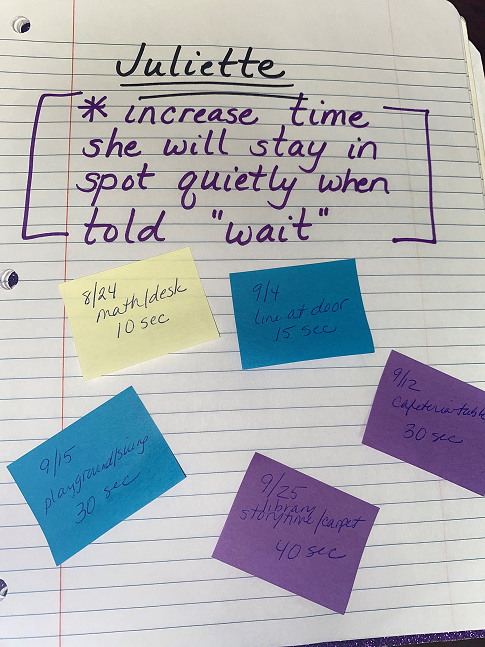
Behavior duration data. Shannon Beyer-Kaminski, 2023
Communication
You may need to take data on your students’ communication skills. Though communication may be tied into academics through specific skills, your students may also have specific functional communication IEP goals. We will talk more about encouraging students’ communication in the November Monthly Instructional Guide.
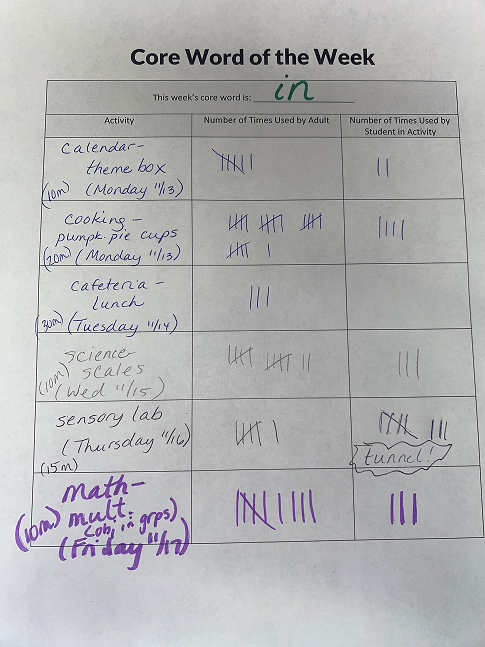
The educator collects data on the frequency of core word use to assist in reporting progress on an IEP goal. Shannon Beyer-Kaminski, 2023
Other Areas as Indicated by IEP Goals
In addition to academics, behavior, and communication, you may be collecting data on other functional IEP goals for your students, such as:
- adapted PE,
- counseling,
- physical therapy,
- occupational therapy,
- or speech therapy.
This month, think about your procedures for handling data collection. Things to consider when refining your system:
- What data collection method makes sense for what you are trying to measure? An antecedent-behavior-consequence (ABC) chart might be needed for trying to address a student’s behavior, while a simple checklist might work for marking who has already been “student of the day.” To take grades for students with complex needs, it may be helpful to use tools like task analysis or rubrics and record the type of cues and prompts needed by the student during an activity. These can be used for both academic and functional tasks.
- Where are data materials stored? Find ways to put data forms near where they will be used by staff, while still maintaining student confidentiality. Setting up organized systems for data will help you find what you need, right when you need it.
- Have all the necessary personnel been trained in how to take the data so that documentation is consistent? Paraprofessionals often assist in collecting classroom data, so include the forms used most frequently in your classroom manual. Make sure paraprofessionals understand how to use the tools. Additionally, collaborate with related service personnel to ensure that everyone is collecting data consistently if working on a co-implemented goal.
- How are you using the data? Some of the information will be used only by yourself, while other data will be discussed with your classroom, campus, and students’ teams. Schedule meetings to review and analyze the information with others to drive your decisions as you monitor student performance and adjust strategies.
- Do you need to know more? If you are not sure about which data collection method to choose or need assistance in reviewing and making sense of the data, reach out to your colleagues or contact your ESC.
Much of the data collected in a self-contained classroom is integrated into students’ present levels of academic achievement and functional performance (PLAAFP) sections of their IEP documents. The ARD committee uses this baseline information to create rigorous, relevant goals and objectives for the student. The data is also used to track student performance for progress monitoring on those goals and objectives. If available, compare data from before the summer break to data from after the break to see if there was any regression in student skills, then note the amount of time it took for the student to recoup those skills so this information can be used to consider a need for extended school year (ESY) services. For specific student data, consider creating student portfolios, which are helpful not only with preparing for ARD committee meetings, but for prepping for conferences and student transitions to new teachers as well.
This rubric uses task analysis for the steps of handwashing, while assigning a point value based on the type of prompt the student required for each step.
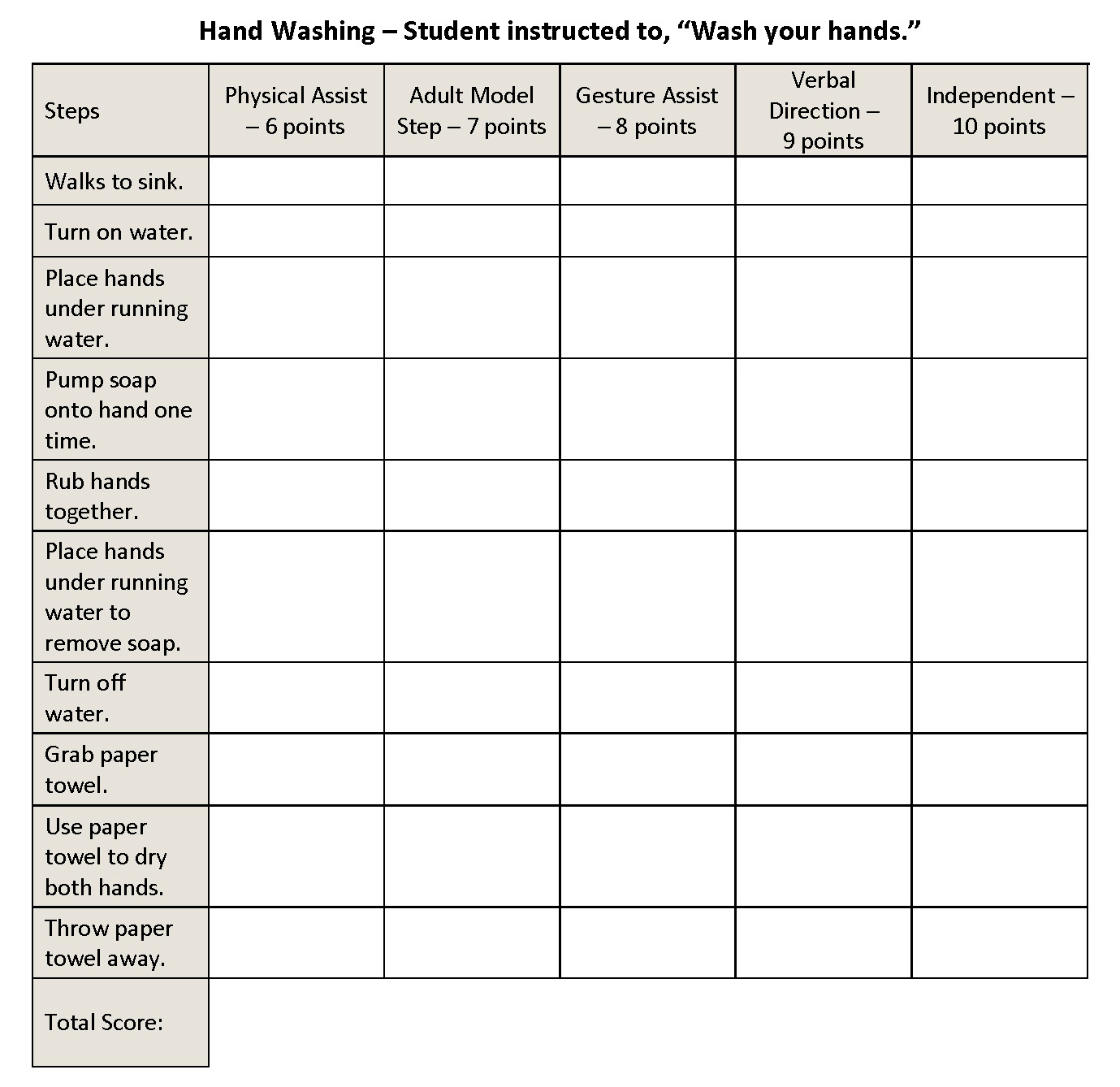
With this form, the score is determined by the number of steps in the skill completed correctly.
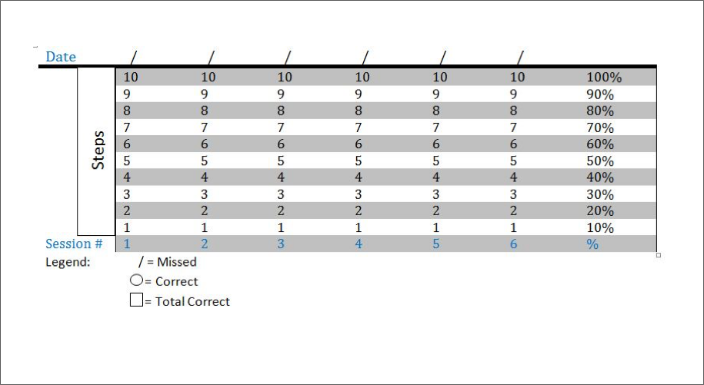
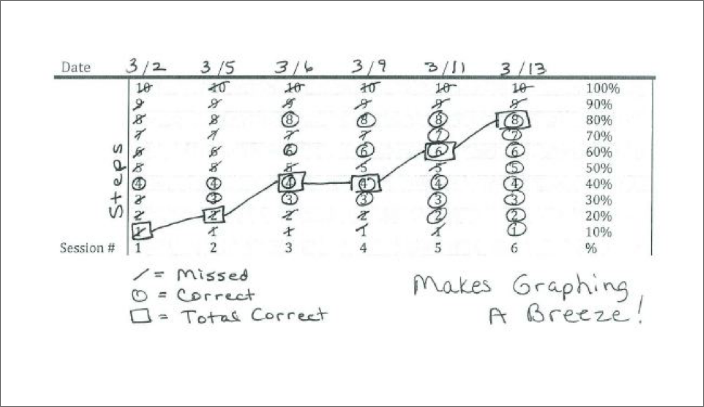
In this form, student performance is marked with a simple check for correct answers and an “x” for incorrect ones.
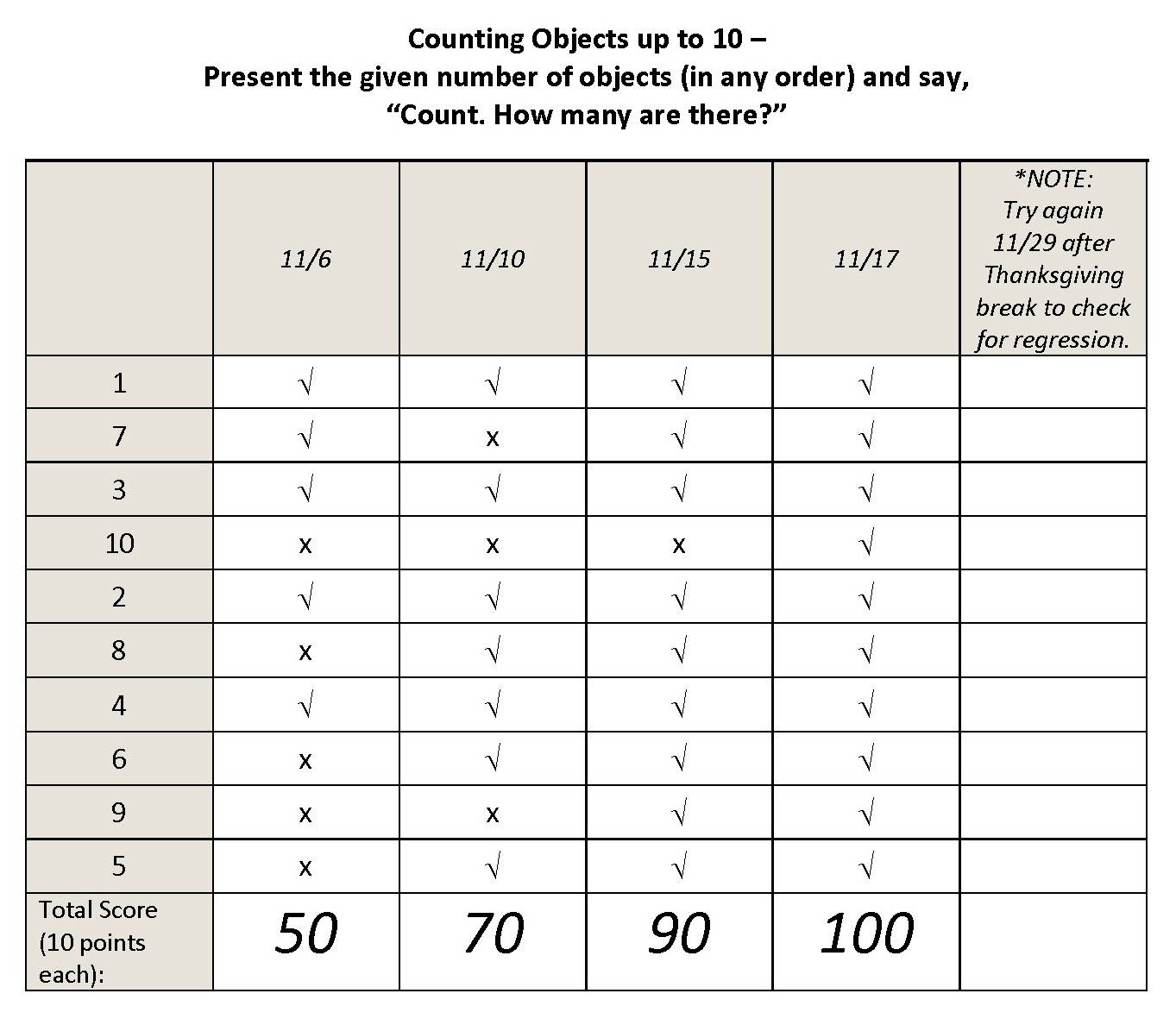
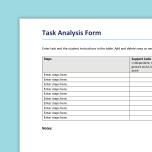
Significant Cognitive Disabilities, Instruction
Task Analysis Form
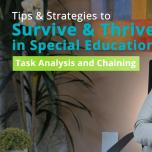
Significant Cognitive Disabilities, Instruction
Task Analysis and Chaining

Autism
Task Analysis
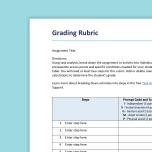
Significant Cognitive Disabilities, Instruction
Sample Grading Rubric for Students with Complex Access Needs

Significant Cognitive Disabilities, Instruction
Sample Data Collection Tool for Students with Complex Access Needs
This data collection tool can be used to document classroom assignments and how they relate to IEP or essence statements, the level of independence in which the student completed the assignment, their level of mastery, and any revisions made to the assignment. This document aligns with the Rubric of
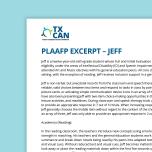
Significant Cognitive Disabilities, ARD/IEP Supports
PLAAFP Excerpt Document For a Student with Complex Access Needs
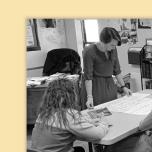
State Guidance, ARD/IEP Supports
Technical Assistance: Individualized Education Program Development
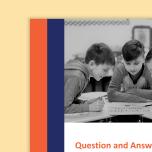
ARD/IEP Supports, State Guidance
Question and Answer: Individualized Education Program (IEP) Measurable Annual Goals
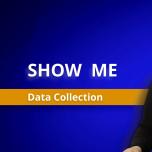
Significant Cognitive Disabilities, Instruction
Data Collection

Significant Cognitive Disabilities, Instruction
Student Portfolios for Students with Complex Access Needs
Extend Your Learning
Learn more about Quality Indicator II: Effective Teams in the Building a Foundation Series course, Quality Indicator II: Effective Teams.

Significant Cognitive Disabilities, ARD/IEP Supports, Instruction
Building a Foundation
Final thought: Promote progress with positive partnerships
You may not have realized how many individuals you encounter through your self-contained classroom. By approaching each relationship with kindness and respect, you create a positive classroom climate where everyone feels safe enough to learn and grow. This month, practice strengthening your relationships with others and refine your data-tracking skills for recording progress.
Looking Ahead
In the October Monthly Instructional Guide, we will cover providing rigorous instruction for your students.
